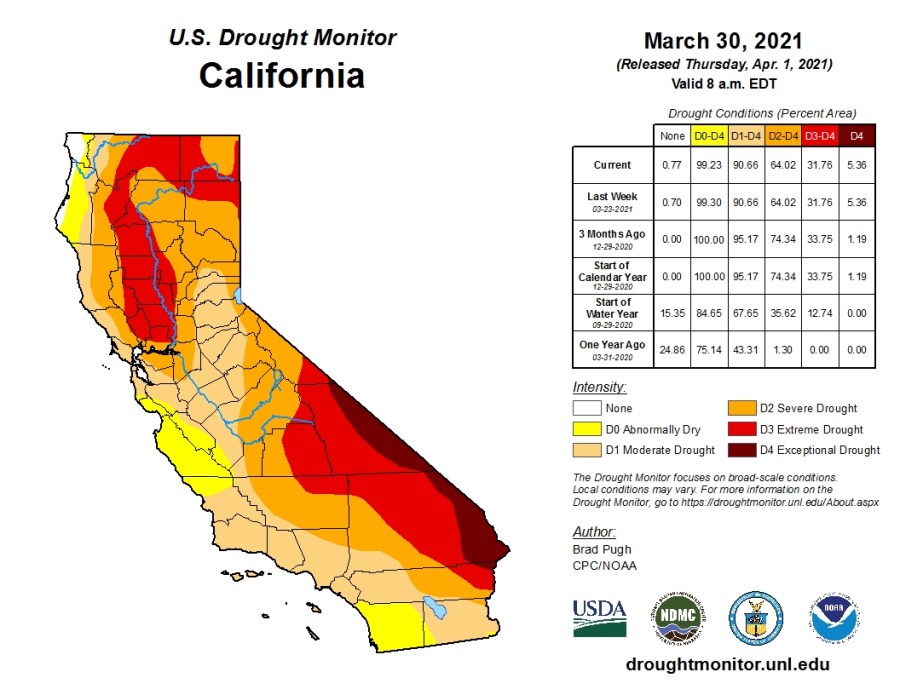Despite the series of winter storms that brought heavy snow and rain across California early this year, the state’s snowpack measures well below normal for this time of year, officials reported Thursday.
The California Department of Water Resources conducted its fourth snow survey of the season at Phillips Station in Sierra Nevada Thursday morning.
The manual survey recorded a snow depth of 49.5 inches and a water content of 21 inches; this time last year it was 16.5. The water content of the overall snowpack was 83% of the April 1 average at that location, officials said.
The Sierra snowpack, which starts building up in the fall, usually supplies about 30% of California’s water each year. The wettest months of the year are typically December, January and February, but this year rain and snowfall at higher elevations fell below average month after month, officials said.
The April 1 survey is typically the most important of the year, when the snowpack is the deepest and has the highest snow-water content. It also marks the end of the wet season for California and is a key indicator for water supply.
The statewide snowpack measured at 16.5 inches, or 59% of the average for this time of the year. The snowpack surveys help water resource officials determine how much snow will melt and runoff into the state’s reservoirs.
Thursday’s statewide snowpack recording is the second straight year of low numbers, after DWR recorded a snowpack of 53% on April 1 a year ago. The consecutive low measurements could mean the return of summer drought conditions and water-use restrictions for the first time since 2016.
Sean de Guzman, the DWR’s chief of snow surveys and water supply forecasting, said the state this year has received about 50% of average precipitation, “which currently ties for the third driest year on record.”
“With below average precipitation statewide, California’s reservoirs continue to show the impacts due to dry conditions,” de Guzman said. “Statewide, California’s largest reservoirs are only storing about half of their total capacity.”
According to de Guzman, the state’s largest reservoir, Lake Shasta, currently contains only 65% of the water it typically holds this time of year, while Lake Oroville held 53% and Folsom Lake had 58%.
Water resource officials said the amount of water expected to enter the state’s reservoirs when the snowpack melts is projected to be just 58% of average. Last year, the April 1 survey runoff forecast was at 60% after a relatively dry winter.
Karla Nemeth, director of the state’s Department of Water Resources, warned that the state will face a critically dry year, and residents will need to adapt quickly to cope with water shortages and a warmer, drier climate.
“While there is some snow on the ground today at Phillips Station, there is no doubt California is in a critically dry year,” Nemeth said in a statement. “State agencies, water suppliers, and Californians are more prepared than ever to adapt to dry conditions and meet the challenges that may be ahead.”
In California, 64% of the state is already in a severe drought, with 5.3% classified as exceptionally dry, according to the U.S. Drought Monitor. A year ago, less than 2% of the state was in severe drought.
As of Tuesday, nearly 98% of the state is under dry conditions or worse, according to the U.S. Drought Monitor from NOAA and the University of Nebraska-Lincoln. That accounts for about 33 million residents currently under drought conditions.

The dry conditions across California carry the potential for more wildfire. Last year, the state saw five of the six largest blazes on record.
The state’s previous drought – which lasted from 2012 to 2016 – resulted in about $2.7 billion in losses for the agriculture industry, and more than 18,000 lost jobs, according to a study by researchers at the University of California, Davis. The drought also contributed to the deaths of about 102 million forest trees, the study found.












